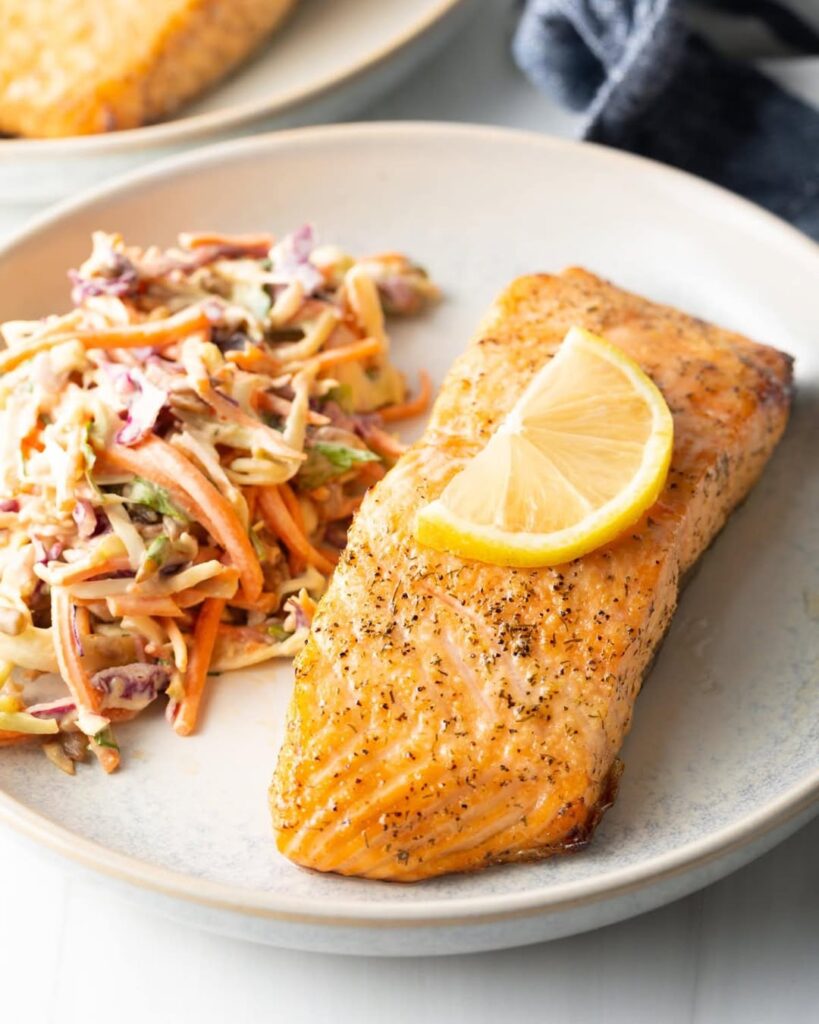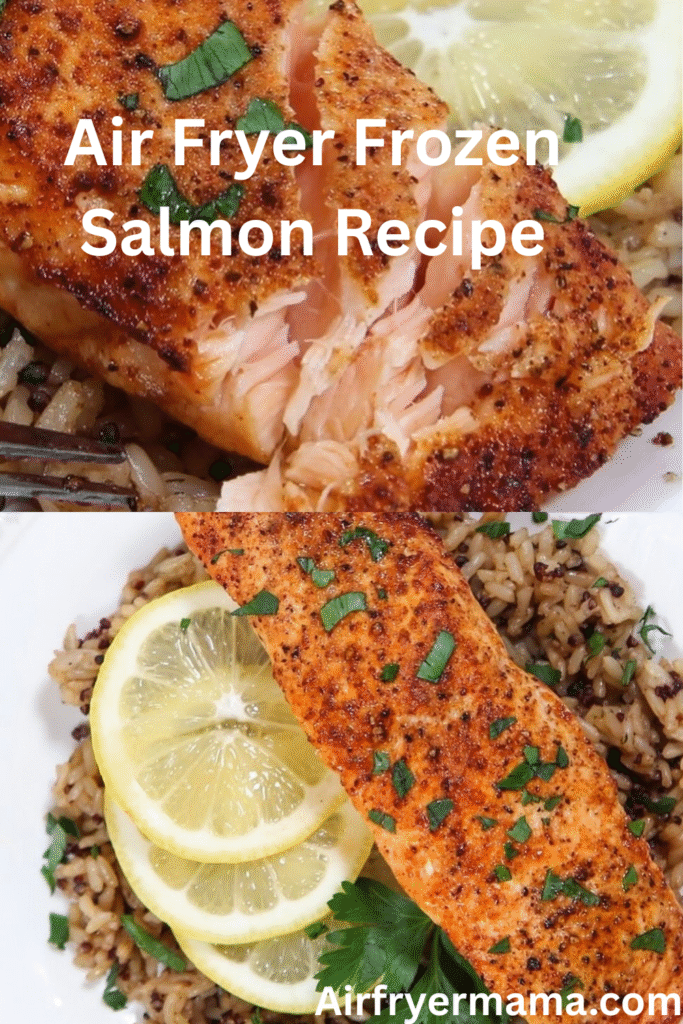Cooking frozen salmon has never been easier, thanks to the air fryer. Whether you’re a seasoned cook or a beginner in the kitchen, the air fryer frozen salmon recipe provides a foolproof way to enjoy a healthy, delicious meal with minimal effort. Unlike traditional methods that require thawing, this recipe lets you skip that step entirely, saving you valuable time. Plus, the air fryer ensures that the salmon comes out with a perfectly crisp exterior and a moist, flaky interior every single time.
Whether you’re meal prepping, hosting a dinner, or looking for a quick weeknight meal, this recipe is versatile, healthy, and downright tasty. And the best part? It’s ready in under 20 minutes! Packed with protein, omega-3 fatty acids, and essential nutrients, salmon is one of the healthiest protein choices you can add to your diet. With this guide, you’ll learn exactly how to transform a frozen salmon fillet into a mouthwatering dish using your air fryer.
Nutrition Facts (Per Serving)
- Calories: 240 kcal
- Protein: 25g
- Carbohydrates: 2g
- Fat: 14g
- Saturated Fat: 3g
- Omega-3 Fatty Acids: High
- Cholesterol: 60mg
- Sodium: 400mg (depending on seasoning)
Recipe Overview
- Cuisine: American, Healthy
- Course: Main Dish
- Servings: 2
- Prep Time: 5 minutes
- Active Cooking Time: 12 minutes
- Resting Time: 3 minutes
- Total Time: 20 minutes
Equipment
- Air fryer (any model will work; adjust times for wattage differences)
- Tongs or spatula
- Small bowl for mixing spices
- Pastry brush (optional for applying oil)
Ingredients
- Frozen Salmon Fillets (6–8 oz each): 2 pieces
- Olive Oil: 1 tablespoon (or avocado oil for higher smoke point)
- Garlic Powder: 1 teaspoon
- Paprika: ½ teaspoon
- Salt: ½ teaspoon (adjust to taste)
- Ground Black Pepper: ½ teaspoon
- Lemon Wedges: Optional, for serving
- Fresh Parsley: Optional, for garnish
Instructions
Step 1: Preheat the Air Fryer
Set your air fryer to 390°F (200°C). Preheating ensures even cooking and a crispy exterior on the salmon. Most air fryers take about 3–5 minutes to reach the desired temperature.
Step 2: Prepare the Salmon
- Remove the frozen salmon fillets from their packaging. If they have any ice crystals on the surface, rinse them under cold water and pat them dry with paper towels.
- Lightly coat both sides of the salmon with olive oil. This helps the seasoning adhere and prevents the salmon from sticking to the air fryer basket.
Step 3: Season the Fillets
- In a small bowl, mix the garlic powder, paprika, salt, and black pepper.
- Sprinkle the seasoning mix evenly over both sides of the salmon fillets. If you prefer, you can add additional spices like cumin, smoked paprika, or a pinch of cayenne for a kick.
Step 4: Arrange in the Air Fryer Basket
- Place the salmon fillets in the air fryer basket skin-side down. Ensure there is enough space between the fillets for air to circulate freely. If you’re cooking multiple fillets, work in batches.
Step 5: Cook the Salmon
- Cook the salmon at 390°F (200°C) for 12–15 minutes, depending on the thickness of the fillets. A general rule is to cook salmon for 10 minutes per inch of thickness.
- At the halfway point (6–7 minutes), use tongs or a spatula to carefully check the fillets. If you want an even crispier finish, lightly brush the tops with additional olive oil.
Step 6: Check for Doneness
- The salmon is done when the internal temperature reaches 145°F (63°C) and the flesh flakes easily with a fork. Use a meat thermometer to ensure accuracy.
Step 7: Rest and Serve
- Remove the salmon from the air fryer and let it rest for 2–3 minutes. Resting allows the juices to redistribute, ensuring a moist, tender bite.
- Serve immediately with a squeeze of fresh lemon juice and a sprinkle of parsley for garnish.
Tips for Success
- No Thawing Needed: This recipe works directly with frozen salmon, so you save time and effort. If using fresh salmon, reduce the cooking time by 2–3 minutes.
- Experiment with Flavors: Add your favorite marinades or spice blends, such as teriyaki sauce, honey mustard, or Cajun seasoning, for a flavor twist.
- Avoid Overcrowding: Air circulation is key to getting perfectly cooked salmon, so don’t overcrowd the air fryer basket.
- Crispy Skin Lovers: If you enjoy crispy salmon skin, make sure the skin is completely dry before seasoning and increase the cooking time by 1–2 minutes.

Serving Suggestions
Pair your air fryer frozen salmon with a variety of sides for a complete, balanced meal. Some great options include:
- Vegetables: Steamed broccoli, roasted asparagus, or a fresh side salad.
- Carbohydrates: Mashed sweet potatoes, quinoa, or brown rice.
- Sauces: A dollop of tzatziki, honey mustard, or a drizzle of garlic butter sauce.
Why Use an Air Fryer for Frozen Salmon?
The air fryer is a game-changer for cooking frozen salmon because it delivers perfectly cooked results in a fraction of the time compared to traditional oven or stovetop methods. The hot circulating air crisps the outside while keeping the inside moist, avoiding the rubbery texture that sometimes occurs with overcooking. Plus, it’s a hands-off method, giving you more time to focus on other meal prep or relax.
Conclusion
The air fryer frozen salmon recipe is a quick and easy way to enjoy a healthy, delicious meal without the hassle of thawing. With just a few simple ingredients and 20 minutes, you’ll have a restaurant-quality dish that’s perfect for any occasion. This method is ideal for busy weeknights, last-minute dinners, or even meal prep.
So the next time you’re staring at frozen salmon in your freezer, grab your air fryer and whip up this foolproof recipe. With its perfect combination of convenience, nutrition, and flavor, it’s bound to become a household favorite.

I am Ashley Doyle, Senior Specialist in Food & Policy at The Humane Society of the United States and editor at airfryermama.com. I am passionate about transforming our global food system by promoting delicious, climate-friendly, plant-based foods. After transitioning from law to food and public policy, I now work with major food service companies to develop plant-based initiatives and animal welfare policies. My goal is to drive institutional change to combat climate change and improve our food system.

